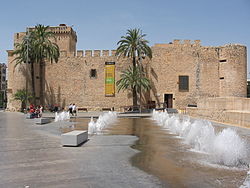Illici
|
Elche Elche / Elx |
|||
|---|---|---|---|
| Municipality | |||

Altamira Castle in Elche
|
|||
|
|||
| Location in Spain | |||
| Coordinates: 38°16′1″N 0°41′54″W / 38.26694°N 0.69833°WCoordinates: 38°16′1″N 0°41′54″W / 38.26694°N 0.69833°W | |||
| Country |
|
||
| Autonomous community |
|
||
| Province | Alicante | ||
| Comarca | Bajo Vinalopó | ||
| Judicial district | Elche | ||
| Founded | Iberos; 5th century BC | ||
| Government | |||
| • Alcalde | Carlos Gonzalez (2015) (PSOE) | ||
| Area | |||
| • Total | 326.10 km2 (125.91 sq mi) | ||
| Elevation | 86 m (282 ft) | ||
| Population (2014) | |||
| • Total | 228,647 | ||
| • Density | 700/km2 (1,800/sq mi) | ||
| Demonym(s) | Ilicitano, ilicitana | ||
| Time zone | CET (UTC+1) | ||
| • Summer (DST) | CEST (UTC+2) | ||
| Postal code | 03200-03299 | ||
| Dialing code | 966 - 965 | ||
| Official language(s) | Spanish and Valencian | ||
| Website |
Official Website Official tourism Website |
||
Elche (/ˈɛltʃeɪ/, Spanish: [ˈelʲt͡ʃe]), or Elx (Valencian: [ˈɛʎt͡ʃ]), is a town located in the comarca of Baix Vinalopó, Spain. According to the 2014 census, Elche has a population of some 228,647 inhabitants (called il·licitans in Valencian and ilicitanos in Spanish), ranking as the third most populated city in the Valencian Community (after Valencia and Alicante) and the 20th largest Spanish city.
Part of the municipality is coastal but the main city is some 11 km (6.8 mi) from the Mediterranean Sea. A small creek called Vinalopó flows through the city splitting it in two parts.
La Alcudia is 10 km from the current city's location and the immediate predecessor of current day Elche. This original location was settled by the Greeks and then occupied by Carthaginians and Romans. Greeks Ionian colonists from the achaian city Helice established their new colony, naming it Helike around 600 BC. The Romans called the city Ilici (or Illice) and granted it the status of colonia; after a brief Byzantine rule, the Goths took over, establishing an episcopal see.
Elche lost importance during the period of Moorish occupation, when it was moved slightly north to its present location. James II of Aragon took the city from the Moors in the 13th century, during the Reconquista. The city grew throughout the 18th century and became more important during the 19th century with the arrival of the railway and a booming industrial development of what used to be the traditional footwear industry.
...
Wikipedia



